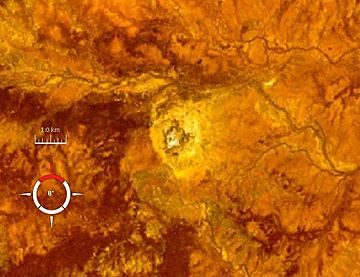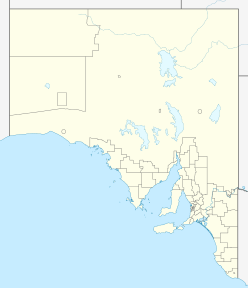Mount Toondina crater facts for kids

Landsat image of Mount Toondina crater; screen capture from the NASA World Wind
|
|
| Impact crater/structure | |
|---|---|
| Confidence | Confirmed |
| Diameter | 4 km (2.5 mi) |
| Rise | 114 m (374 ft) |
| Age | <110 Ma <Early Cretaceous |
| Exposed | Yes |
| Drilled | No |
| Location | |
| Location | Eromanga Basin |
| Coordinates | 27°56′40″S 135°21′30″E / 27.94444°S 135.35833°E |
| Country | Australia |
| State | South Australia |
| District | Allandale Station |
The Mount Toondina crater is a special place in northern South Australia. It's not a volcano, but an impact structure. This means it was formed a very long time ago when a large space rock, like an asteroid, crashed into Earth.
Today, what we see is mostly the "eroded remnant" of that crash. This means wind, rain, and time have worn away much of the original crater. It's located near Allandale Station, about 24 kilometers (15 miles) south of the town of Oodnadatta.
Mount Toondina itself is the highest point of a circular shape that stands out in the otherwise flat desert. It's like a big, round bump in the ground.
Discovering the Crater's Secret
For a long time, people weren't sure how Mount Toondina was formed. Some thought it might be a diapir, which is a type of salt dome. This is where a big blob of salt pushes up through layers of rock.
However, in 1976, scientists suggested a new idea: it was actually an impact crater! Later studies strongly supported this idea.
How Scientists Found Out
Scientists used a method called a geophysical survey. This is like using special tools to look deep under the ground without digging. They used "gravity methods," which measure tiny changes in Earth's gravity. These changes can tell scientists about the different types of rocks and structures hidden below.
This survey showed that Mount Toondina has an "internal structure" that looks just like other "complex impact craters." These craters often have a raised area in the middle, called an "uplifted centre." This happens when the ground bounces back up after a huge impact.
The survey suggested that the original crater was quite large, about 3 to 4 kilometers (1.9 to 2.5 miles) wide.
When Did the Impact Happen?
Scientists know that the Mount Toondina crater must be younger than the rocks it's found in. These rocks are from the Early Cretaceous period, which was more than 110 million years ago!
However, the exact date of the impact is not known for sure. We do know that since the impact, the crater has been significantly "eroded." This means it has been worn down a lot by natural forces over millions of years.


